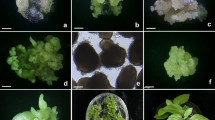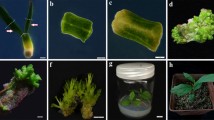Abstract
Simple, reproducible, high frequency, improved plant regeneration protocol in Eastern Cottonwood (Populus deltoides) clones, WIMCO199 and L34, has been reported. Initially, aseptic cultures established from axillary buds of nodal segments from mature plus trees on MS liquid medium supplemented with 0.25 mg l−1 KIN and 0.25 mg l−1 IAA. Nodal and internodal segments were found to be extra-prolific over shoot apices during course of aseptic culture establishment, while 0.25 mg l−1 KIN concentration played a stimulatory role in high frequency plant regeneration. Diverse explants, such as various leaf segments, internodes, and roots from in vitro raised cultures, were employed. Direct plant regeneration was at high frequency of 92% in internodes, 88% in leaf segments, and 43% in root segments. This led to the formation of multiple shoot clusters on established culture media with rapid proliferation rates. Many-fold enhanced shoot elongation and growth of the clusters could be achieved on liquid MS medium supplemented with borosilicate glass beads, which offer physical support for proliferating shoots leading to faster growth in comparison to semi-solid agar or direct liquid medium. SEM examination of initial cultures confirmed direct plant regeneration events without intervening calli. In vitro regenerated plants induced roots on half-strength MS medium with 0.15 mg l−1 IAA. Rooted 5- to 6-week-old in vitro regenerated plants were transferred into a transgenic greenhouse in pots containing 1:1 mixture of vermicompost and soil at 27 ± 2°C for hardening and acclimatization. 14- to 15-week-old well-established hardened plants were transplanted to the field and grown to maturity. The mature in vitro raised poplar trees exhibited a high survival rate of 85%; 4-year-old healthy trees attained an average height of 8 m and an average trunk diameter of 25 cm and have performed well under field conditions. The regeneration protocol presented here will be very useful for undertaking genetic manipulation, providing a value addition to Eastern Cottonwood propagation in future.




Similar content being viewed by others
Abbreviations
- BAP:
-
6-Benzylaminopurine
- IAA:
-
Indole-3-acetic acid
- KIN:
-
Kinetin
- MS:
-
Murashige and Skoog
- SEM:
-
Scanning electron microscopy
References
Bolstad PV, Libby WJ (1982) Comparison of radiata pine cutting of hedge and tree form origin after seven growing seasons. Silvae Genet 31:9–13
Borchert R (1976) The concept of rejuvenility in woody plants. Acta Hortic 56:21–36
Chaturvedi HC, Sharma AK, Agha BQ, Jain M, Sharma M (2004) Production of clonal trees of Populus deltoides through in vitro regeneration of shoots from leaf, stem and root explants and their field cultivation. Indian J Biotechnol 2:203–208
Chaudhury A, Qu R (2000) Somatic embryogenesis and plant regeneration of turf type Bermudagrass: effect of 6-Benzyladenine in callus induction medium. Plant Cell Tissue Organ Cult 60:113–120
Coleman GD, Ernst SG (1989) In vitro shoot regeneration of Populus deltoides: effect of cytokinin and genotype. Plant Cell Rep 8:459–462
Coleman GD, Ernst SG (1990) Shoot induction competence and callus determination in Populus deltoides. Plant Sci 71:83–92
Greenwood MS (1987) Rejuvenation of forest trees. Plant Growth Regul 6:1–12
Hackett WP (1985) Juvenility, maturation, and rejuvenation in woody plants. Hortic Rev 7:109–155
Halperin W (1973) The use of cultured tissue in studying developmental problems. Can J Bot 51:1801–1806
Hu WJ, Harding SA, Lung J, Popko JL, Ralph J, Stokke DD, Tsai CJ, Chiang VL (1999) Repression of lignin biosynthesis promotes cellulose accumulation and growth in transgenic trees. Nat Biotechnol 17:808–812
Jansson S, Douglas CJ (2007) Populus: a model system for plant biology. Annu Rev Plant Biol 58:435–458
Klee HJ, Horsch RB, Hinchee MA, Hein MB, Hoffman NL (1987) The effects of overproduction of two Agrobacterium tumefaciens T-DNA auxin biosynthetic gene products in transgenic petunia plants. Genes Dev 1:86–96
MacLeod K, Nowak J (1990) Glass beads as a solid matrix in in vitro study of the role of polyamines in cold hardiness of white clover. Plant Cell Tissue Org Cult 22:113–117
Michler CH, Bauer EO (1991) High frequency somatic embryogenesis from leaf tissue of Populus Spp. Plant Sci 77:111–118
Murashige T, Skoog F (1962) A revised medium for rapid growth and bioassays with tobacco tissue cultures. Physiol Plant 15:473–497
Son SH, Hall RB (1990) Plant regeneration capacity of callus derived from leaf, stem, and root segments of Populus alba L.× P. grandidantata Michx. Plant Cell Rep 9:344–347
Stoutemyer VT, Britt OK (1965) Tissue cultures of juvenile and adult specimens of ivy. Nature 199:397–398
Stoutemyer VT, Britt OK (1969) Growth and habituation in tissue cultures of English ivy, Hedera helix. Am J Bot 56(2):222–226
Thakur AK, Sharma DK (2006) High efficiency plant regeneration from leaf explants of male Himalayan poplar (P. ciliata wall). In Vitro Cell Dev Biol Plant 42:144–147
Thakur AK, Sharma S, Srivastava DK (2005) Plant regeneration and genetic transformation studies in petiole tissue of Himalayan poplar (Populus ciliata Wall.). Curr Sci 89:664–668
Tsvetkov I, Hausman JF, Jouve L (2007) Thidiazuron-induced regeneration in root segments of white poplar (P. alba L.). Bulg J Agric Sci 13:623–626
Vasil V, Vasil IK (1984) Preparation of cultured tissues for scanning electron microscopy. In: Vasil IK (ed) Cell culture and somatic cell genetics of plants. Laboratory procedures and their applications, vol 1. Academic Press, New York, USA, pp 738–743
Winten LL (1968) Plantlet formation from aspen tissue culture. Science 160:1234–1235
Wolter KE (1968) Root and shoot initiation in aspen callus culture. Nature 219:503–510
Acknowledgments
This work was supported by the Department of Biotechnology, Ministry of Science & Technology, Government of India, New Delhi as a research project to Prof. A. Chaudhury. Mr. Rakesh Yadav, Mr. Dharmendar Kumar and Mr. Dinesh Katyal duly acknowledge financial assistance in the form of JRF’s and Technical Assistant in Department of Biotechnology sponsored project. The authors wish to express their gratitude to Dr. H.C. Chaturvedi, Emeritus Scientist, NBRI (CSIR), Lucknow and Dr. Vibha Dhawan, Vice Chancellor, TERI University for providing plant material and rendering help in initial phase of work. The transgenic greenhouse, tissue culture facility were established under the FIST program, and financial assistance in form of color reproduction fee for manuscript figure was provided under BT-19 Project, Department of Science & Technology, Ministry of Science & Technology, Government of India, New Delhi.
Author information
Authors and Affiliations
Corresponding author
Rights and permissions
About this article
Cite this article
Yadav, R., Arora, P., Kumar, D. et al. High frequency direct plant regeneration from leaf, internode, and root segments of Eastern Cottonwood (Populus deltoides). Plant Biotechnol Rep 3, 175–182 (2009). https://doi.org/10.1007/s11816-009-0088-5
Received:
Accepted:
Published:
Issue Date:
DOI: https://doi.org/10.1007/s11816-009-0088-5




